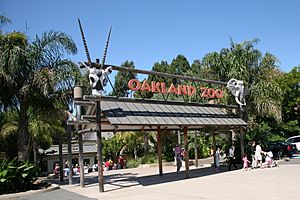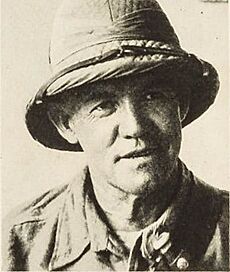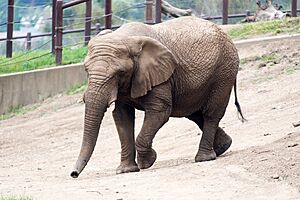Oakland Zoo facts for kids

Main entrance
|
|
| Date opened | 1922 |
|---|---|
| Location | 9777 Golf Links Rd. Oakland, California 94605 |
| Land area | 100 acres (40 ha) |
| Coordinates | 37°45′03″N 122°08′52″W / 37.7508°N 122.1477°W |
| No. of animals | 850+ |
| Annual visitors | 975,000 |
| Memberships | AZA |
The Oakland Zoo is a zoo located in the Grass Valley neighborhood of Oakland, California, United States. Established on June 6, 1922, it is managed by the Conservation Society of California, a 501(c)(3) non-profit organization dedicated to the conservation of wildlife both locally and globally. The zoo is home to more than 850 native and exotic animals and is a member of the Association of Zoos and Aquariums (AZA).
The zoo is recognized for its outstanding leadership in animal welfare, animal care, particularly its elephant care program, its rescue, rehabilitation and conservation programs and for its LEED-certified, 17,000-square-foot, state-of-the-art veterinary hospital—the largest wild animal veterinary facility in Northern California.
Oakland Zoo is the recipient of numerous "Best of" awards, including 30 Best U.S. Zoos by U.S. News & World Report and "10 Best" by USA Today Reader's Choice Awards. On July 12, 2018, the Oakland Zoo opened the California Trail, focusing on the state's remarkable native wildlife—both past and present.
Contents
History
Naturalist Henry A. Snow established the Oakland Zoo on June 6, 1922 - originally at 19th and Harrison streets in downtown Oakland. Snow Park now occupies the site of the zoo's first home.
Over the years the zoo relocated several times: first to Sequoia Park, then Joaquin Miller Park and finally in 1939 to Durant Park. Under Joseph R. Knowland, chairman of the California State Park Commission, California, purchased the land and in 1950 renamed the park to Joseph Knowland State Arboretum and Park.[1]
In 1936, Henry A Snow's son, Sidney Snow, established the nonprofit organization East Bay Zoological Society, which was originally known as the Alameda County Botanical and Zoological Society. The East Bay Zoological Society operated and managed the zoo for the City of Oakland from 1982 until August 2017, when it was renamed the Conservation Society of California to better reflect the zoo's evolving purpose and mission in its commitment to conservation. Governed by a volunteer board of trustees, the Conservation Society of California manages and operates Oakland Zoo.
With over 25 wildlife conservation partners globally, the zoo provides funds to support their programs and efforts to save wildlife. Through their partnerships with California Department of Fish & Wildlife, they accept, rehabilitate, and re-home wildlife rescued from wildfire and human-wildlife conflict. This has included 22 mountain lions, 38 California condors, 8 bears, and over 600 yellow-legged frogs.
Expansion
New exhibits have been created, including those for the hamadryas baboons and the chimpanzees. A spacious elephant exhibit was built in 1987. The sun bear exhibit was finished in 1995 and was featured on Animal Planet Ultimate Zoos. The white-handed gibbons live on a lush island in the heart of the Tropical Rainforest on Gibbon Island. The African Savannah, with camels, lions, elephants, meerkats, hyenas and more, was completed in 1998.
The Education Center opened its doors in 1999 and the main entrance followed soon in summer 2001. In autumn of 2001, a squirrel monkey exhibit opened along with a larger, renovated tiger exhibit. In the spring of 2007, the four dromedary camels were moved to a larger, fenced enclosure uphill from their old enclosure.
Oakland zoo provides free and discounted science education programs for underserved students attending Title 1 schools in the Greater Bay Area. It gives 5,500 vouchers every year to schools and community organizations as part of its Zoo-to Community program. It reaches an average of over 3,000 students and 1,000 adults yearly.
In 2012, a fully funded LEED-certified veterinary hospital opened, followed by the opening in 2013 of the Oakland Zoo Biodiversity Center, and the 2014 inauguration of the Condor Recovery Center at Oakland Zoo. Each of these projects has improved care of the zoo's animals as well as conservation of the species in the wild.
California Trail
California Trail represented $70 million out of an $81 million multi-phase zoo development. Through live native animal and plant habitats, the zoo highlights the delicate balance between humans and nature, and the impact of change on all three.
Guests travel to the trail via an aerial gondola from the existing zoo. Along the trail, they encounter animals such as bears, wolves, mountain lions, bison and birds of prey. The half-acre California Wilds! playground introduces young children and their families to California wildlife and habitats through themed play structures. Inside the Conservation Habitarium - with a wall-length window into the grizzly bear habitat, visitors explore California's diverse habitats, step into the shoes of conservation researchers, and find their place as a member of a community of people taking action for California's wildlife. The project was designed by Noll & Tam Architects and built by C. Overaa & Co.
California Trail is an example of the Oakland Zoo's leadership in captive animal welfare, and its commitment to providing natural and enriched environments to promote species-typical behaviors for captive wildlife. California Trail is a model for other zoological facilities, sending the critical message that zoos have an important role to play in the rescue, rehabilitation, and care of wildlife...Oakland Zoo has long prioritized common sense and welfare, and PETA looks forward to continued collaboration on improving the welfare of captive wildlife across the U.S.
The Wayne and Gladys Valley Children's Zoo
In the summer of 2005 the 3-acre (12,000 m2) Valley Children's Zoo opened with spacious new animal exhibits along with plenty of interactive play-structures for children. The lemurs, tortoises, the interactive Goat and Sheep Contact Yard along with the river otters can be found in the Children's Zoo. Alligators, bats, pigs, and rabbits along with the Bug Room, and the Reptile and Amphibian Discovery Room are also in the Children's Zoo. One feature popular with younger children is brass insects embedded in the concrete walkways, which were installed as a form of public art.
Animals at Oakland Zoo
Flamingo Plaza
Tropical Rainforest
African Savanna
- African elephant
- African lion
- African sacred ibis
- Ball python
- Black-throated monitor
- Blue-bellied roller
- Common warthog
- Dromedary camel
- Egyptian goose
- Fischer's lovebird
- Giant plated lizard
- Grant's zebra
- Hamadryas baboon
- Hamerkop
- Klipspringer
- Meerkat
- Pancake tortoise
- Pied crow
- Red-bellied parrot
- Red-tailed monkey
- Reticulated giraffe
- Rock hyrax
- Speckled pigeon
- Spotted hyena
- Sudan plated lizard
- Superb starling
- Taveta weaver
- White-faced whistling duck
Wayne and Gladys Valley Children's Zoo
- African spurred tortoise
- Aldabra giant tortoise
- Amazon tree boa
- American alligator
- Asian forest scorpion
- Black beauty stick insect
- Black tree monitor
- Black widow spider
- Blue spiny lizard
- Brown anole
- Caribbean giant cockroach
- Chilean rose tarantula
- Chuckwalla
- Colombian red-tailed boa
- Common carrion beetle
- Crowned lemur
- Desert tortoise
- Domestic rabbit
- Dyeing poison dart frog
- Eastern box turtle
- Florida red-bellied cooter
- Giant African millipede
- Giant vinegaroon
- Gila monster
- Goat
- Golden mantella
- Golfodulcean poison frog
- Green and black poison dart frog
- Green anole
- Green mantella
- Guinea Hog
- Henkel's leaf-tailed gecko
- Island flying fox
- Jungle nymph
- Large flying fox
- Leafcutter ant
- Madagascar hissing cockroach
- Mission golden-eyed tree frog
- North American river otter
- Panamanian golden frog
- Ring-tailed lemur
- Spotted turtle
- Three-toed box turtle
- Yellow-banded poison dart frog
Wild Australia
California Trail
Glowfari
Glowfari is a light event hosted by the zoo in the winter. It features larger-than-life lantern animals. The path is one mile long and features more than 100 animals and more than 800 additional light displays. There are three worlds: Aquatic, Ecosystem/Food chain, and Jurassic.
Gallery















